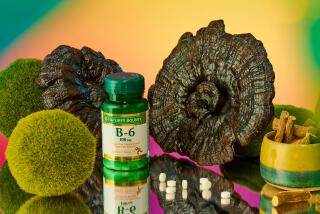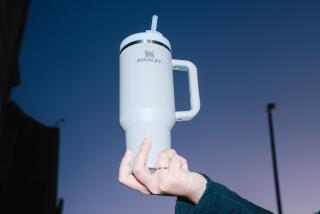A Beer Women Can Call Their Own
- Share via
EMERYVILLE, Calif. — San Francisco arts impresario Sydney Goldstein looks elegantly out of place as she steps carefully through the puddles on the floor of the Golden Pacific Brewery to attend to her latest creation.
Usually you’ll find her working telephones in the tiny storefront office of City Arts & Lectures, coaxing to town renowned figures in literature and the performing arts. She has fine-tuned “an evening with” for guests like author Joan Didion, blues guitarist B.B. King, journalist Ben Bradlee and cellist Yo-Yo Ma, getting them to chat relaxedly with special interviewers.
But now she is here in her navy I. Magnin sweater and skirt, chatting with the brawny brewery workers who are coaxing from a kettle of wort a new product. It is dubbed “Sophie McCall”--the women’s beer, with an allure embodied on a test-bottling label that proclaims it “the Queen of Beers” and promises “added calcium.” In fact, it has eight to 10 times the 15 milligrams contained in a bottle of Budweiser, and that’s one of its key selling points.
Goldstein stretches her 5-foot-2-inch, 105-pound frame as tall as possible so she can look down into a shiny copper vat of malted barley mixing with water. “I love that aroma,” she says, breathing deeply of the heady vapors.
Goldstein, 51, who has a mop of dark curls and an impish smile, loves her beer. It’s a love nurtured from youth. “My parents both thought it was healthy for kids to learn how to drink at home. And they also were trying to put some meat on my bones.” But what really brought her here today was a transcendent moment when she realized that, after 20 or more years of business lunches, she simply couldn’t face another glass of white wine.
“I’m always eating in good California cuisine restaurants that pride themselves on serving very fresh ingredients,” Goldstein explained while showing a visitor around the brewery. “Beer is not foreign to those places, but it’s a little foreign to [find] women ordering beer in those places. And I am personally tired of drinking chardonnay all of the time.”
Beer asserts itself as an equal to fine wine in many exclusive circles. For instance, on the steamy August day in 1994 when her brother-in-law, Stephen G. Breyer, became a member of the U.S. Supreme Court, Goldstein said, Chief Justice William H. Rehnquist joined him in toasting the occasion with an ice-cold beer.
Goldstein first toyed with the idea of a beer for women a decade ago, but dropped it when she confided her dream to a brewing executive, who responded with derisive laughter. The idea came back to life last year when she found out that David Harnden, whose daughter attends her son’s school, brews for a living.
“The idea rang true because [calcium is] a big issue,” Harnden said as he joined the tour. His tiny 10,000-barrel-a-year operation made a splash at last fall’s Great American Beer Festival in Denver by winning a gold medal for one of its flagship brands, Golden Gate Original Ale. A lanky 50-year-old, Harnden is a former physician who bought Golden Pacific six years ago.
“I view beer as a food thing. I certainly have dealt with alcoholism in my career, and I’m very much against it. But when I taste beer I love the flavor,” he said. “And if you can do anything to add to the benefits, that catches my ear.”
To get the calcium, they looked up Mary Miranda, a research associate at the University of California, Davis, which offers a degree program in fermentation science.
“Actually, I’d like to see young girls drink more beer than Coke,” said Miranda, tackling the project with enthusiasm. There is a little calcium in every beer, she pointed out, and it can be enhanced by manipulating the brewing process to keep the calcium salts that are found naturally in hard water.
The result is Sophie McCall, which Goldstein describes as “a golden, full-bodied, old-fashioned beer with a slight sweetness and no bitter aftertaste. It will be a beer that men will want to drink too.” Golden Pacific’s vice president for marketing, David Rosenberg, expects a summertime roll-out in the Bay Area and introduction in Southern California late in the year.
The concept of using that spoonful of sugar to help the medicine go down is not new: It was once suggested that wine be vitamin-fortified. So health professionals don’t automatically condemn Sophie.
Sandra C. Raymond, executive director of the National Osteoporosis Foundation in Washington, D.C., points out that alcohol abuse is one of many factors, including lack of dietary calcium, contributing to so-called brittle-bone disease. Osteoporosis contributes to fractures in an estimated 1 million post-menopausal women annually and is regarded as the third-leading cause of mortality for women.
Raymond, whose organization exhorts women to ingest the 1,000 to 1,500 milligrams of calcium a day recommended by the National Institutes of Health, said she’d like some assurance that the calcium in Sophie McCall is in a form that can be readily absorbed by the body so it can contribute to bone mass, the rate of which is measured by so-called bioavailability.
“I look at it this way: I think it’s fine,” Raymond said. “If I have a young girl who is 18 or 19 or 20 years old and she is going to drink a couple of glasses of beer a week, and she’s getting some calcium she wouldn’t get otherwise, then I think that’s a good thing as long as it is bioavailable, and that’s the issue.”
Judith Ashley, assistant professor of nutrition at UCLA, said young American women typically switch from milk--with its 291 milligrams of calcium per 8-ounce glass--to diet sodas at an inopportune life stage.
“The calcium intake to avoid osteoporosis is needed more in your 20s and 30s than in your 50s and 60s,” Ashley said, noting that many nutritionists suggest women take calcium-supplement tablets. “So our concern is young people who stop drinking milk and getting calcium in their diet and don’t take a supplement. And then, when they get about 40 or 50, it’s a little too late.
“People do need more calcium,” Ashley added. “When they first put it in orange juice [in 1987 test marketings] people were aghast, but it happens to be a pretty good vehicle. We would want to know: Is it really well absorbed from the beer?”
It happens that Dr. Robert P. Heaney, a professor of medicine at Creighton University and one of the leading authorities on nutritional calcium, is also a beer lover. Heaney, who conducted key industry tests that showed human subjects can absorb calcium from enriched orange juice, said he believes that calcium in beer enters bones readily because it is in soluble form. At any rate, he said, “I’d love to test it. I’m sure we’d get plenty of volunteers.”
But even so, there are naysayers--such as microbrewery pioneer Bill Owens of Hayward, creator of Buffalo Bill’s beer and publisher of American Beer and Beer magazines. “I’m skeptical that women will drink beer to solve a calcium problem. I’m against promoting beer for health reasons,” Owens said. “They should drink a beer to get a little extra protein, some empty calories and a little alcohol in their blood for a little levitation--to enjoy their lives.”
Meeting the challenge of bringing a new product to market has already brought enjoyment to Goldstein, who is busy plotting marketing strategies.
“We are going to develop a team of middle-aged women selling it. A team of very good-looking middle-aged women going out to special places to spread this beer around,” she said.
And she has hired the design firm Monnens-Addis to create a new look for the beer’s roll-out. “They are doing a label to my precise specifications. I know the photograph I want to take: A woman’s back in a one-piece bathing suit and a dog’s back. Do you want to look like this dog or this woman? And they both have very nice backs.”
More to Read
The biggest entertainment stories
Get our big stories about Hollywood, film, television, music, arts, culture and more right in your inbox as soon as they publish.
You may occasionally receive promotional content from the Los Angeles Times.










